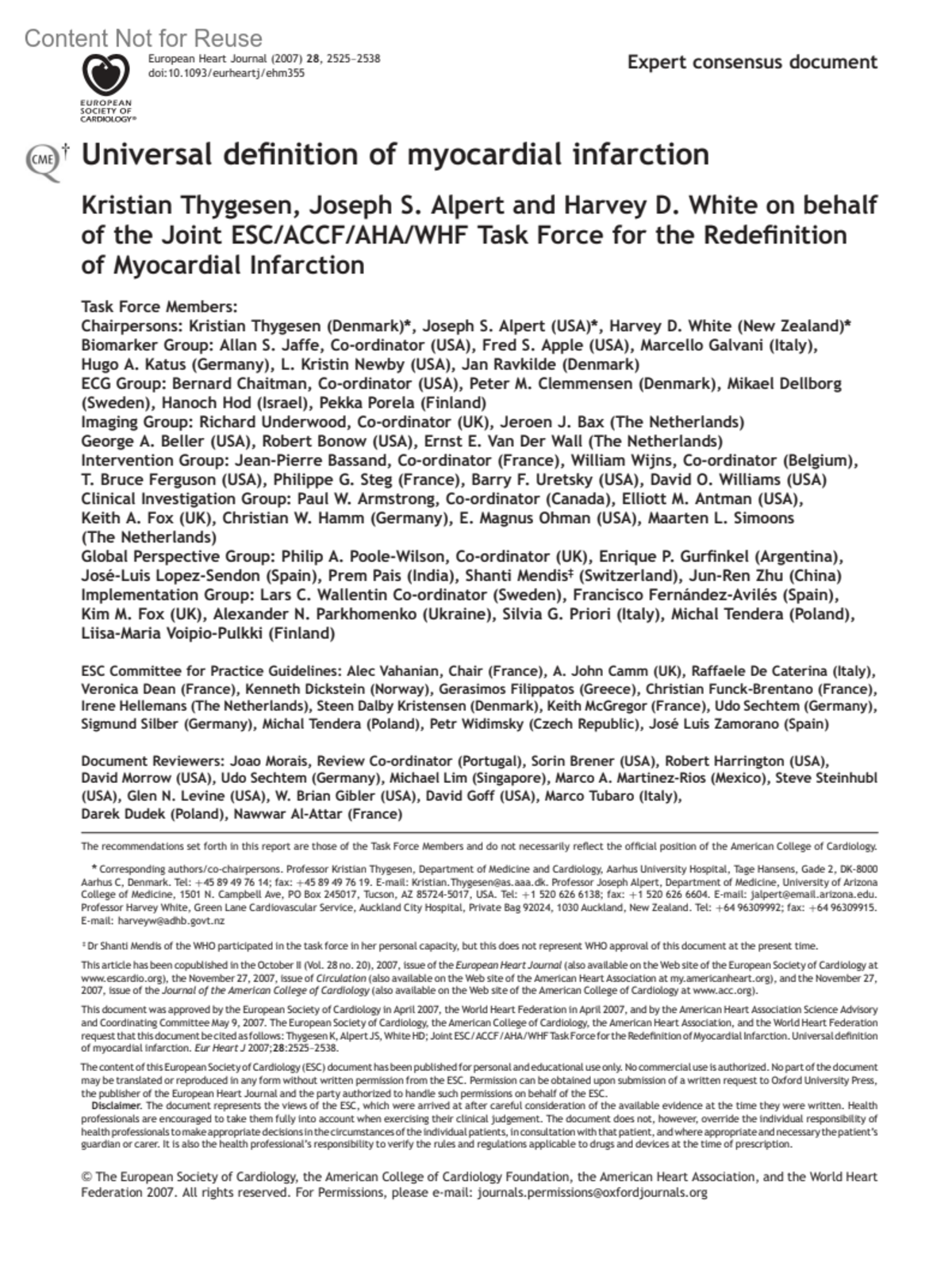The recommendations set forth in this report are those of the Task Force Members and do not necessarily reflect the official position of the American College of Cardiology.
*Corresponding authors/co-chairpersons. Professor Kristian Thygesen, Department of Medicine and Cardiology, Aarhus University Hospital, Tage Hansens, Gade 2, DK-8000 Aarhus C, Denmark. Tel: +45 89 49 76 14; fax: +45 89 49 76 19. E-mail: [email protected]. Professor Joseph Alpert, Department of Medicine, University of Arizona College of Medicine, 1501 N. Campbell Ave, PO Box 245017, Tucson, AZ 85724-5017, USA. Tel: +1 520 626 6138; fax: +1 520 626 6604. E-mail: [email protected]. Professor Harvey White, Green Lane Cardiovascular Service, Auckland City Hospital, Private Bag 92024, 1030 Auckland, New Zealand. Tel: +64 96309992; fax: +64 96309915. E-mail: [email protected]
‡Dr Shanti Mendis of the WHO participated in the task force in her personal capacity, but this does not represent WHO approval of this document at the present time.
This article has been copublished in the October II (Vol. 28 no. 20), 2007, issue of the European Heart Journal (also available on the Web site of the European Society of Cardiology at www.escardio.org), the November 27, 2007, issue of Circulation (also available on the Web site of the American Heart Association at my.americanheart.org), and the November 27, 2007, issue of the Journal of the American College of Cardiology (also available on the Web site of the American College of Cardiology at www.acc.org).
This document was approved by the European Society of Cardiology in April 2007, the World Heart Federation in April 2007, and by the American Heart Association Science Advisory and Coordinating Committee May 9, 2007. The European Society of Cardiology, the American College of Cardiology, the American Heart Association, and the World Heart Federation request that this document be cited as follows: Thygesen K, Alpert JS, White HD; Joint ESC/ACCF/AHA/WHF Task Force for the Redefinition of Myocardial Infarction. Universal definition of myocardial infarction. Eur Heart J 2007;28:2525–2538.
The content of this European Society of Cardiology (ESC) document has been published for personal and educational use only. No commercial use is authorized. No part of the document may be translated or reproduced in any form without written permission from the ESC. Permission can be obtained upon submission of a written request to Oxford University Press, the publisher of the European Heart Journal and the party authorized to handle such permissions on behalf of the ESC.
Disclaimer. The document represents the views of the ESC, which were arrived at after careful consideration of the available evidence at the time they were written. Health professionals are encouraged to take them fully into account when exercising their clinical judgement. The document does not, however, override the individual responsibility of health professionals to make appropriate decisions in the circumstances of the individual patients, in consultation with that patient, and where appropriate and necessary the patient's guardian or carer. It is also the health professional's responsibility to verify the rules and regulations applicable to drugs and devices at the time of prescription.
†The CME Text ‘Universal definition of myocardial infarction’ is accredited by the European Board for Accreditation in Cardiology (EBAC) for ‘1’ hour of external CME credits. Each participant should claim only those hours of credit that have actually been spent in the educational activity. EBAC works according to the quality standards of the European Accreditation Council for Continuing Medical Education (EACCME), which is an institution of the European Union of Medical Specialists (UEMS). In compliance with EBAC/EACCME guidelines, all authors participating in this programme have disclosed potential conflicts of interest that might cause a bias in the article. The Organizing Committee is responsible for ensuring that all potential conflicts of interest relevant to the programme are declared to the participants prior to the CME activities.
CME questions for this article are available at: EuropeanHeartJournalhttp://cme.oxfordjournals.org/cgi/hierarchy/oupcme_node;ehj and European Society of Cardiologyhttp://www.escardio.org/knowledge/guidelines.

